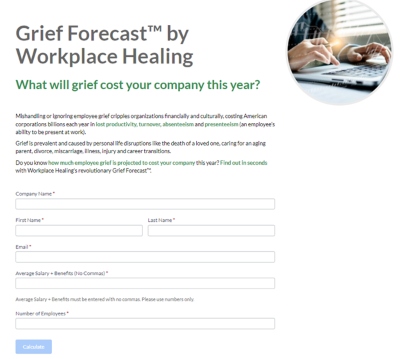
How Much is Grief Costing Your Company? Find Out Now.
With Workplace Healing’s groundbreaking Grief Forecast™, learn how much lost productivity, turnover and on-the-job errors will cost your company this year.
Employee life disruptions cause grief and cost companies billions each year in lost productivity, turnover and on-the-job errors. Determining your company’s grief-related financial risks has been a mystery—until now.
Introducing the Grief Forecast™ by Workplace Healing.
For the first time ever, you can measure exactly how much grief is likely to cost your company this year.
What’s driving the numbers?
With one in four employees grieving at any given time (Grief Recovery Institute), the prevalence of life disruptions that cause grief cannot be underestimated. Common life disruptions include:
- Death of a loved one.
- Divorce.
- Miscarriage.
- Caring for an aging parent.
- Receiving a life-altering medical diagnosis.
- Illness.
- Injuries.
- Career transitions.
With its revolutionary algorithm, the Grief Forecast™ calculates the number of employees and the average salary at your company to predict the financial risks your organization is likely to incur due to grief-related productivity loss and employee turnover.
Lost productivity.
Grief-related productivity loss is a key driver of absenteeism and presenteeism. Here’s why:
- Absenteeism. A disrupted employee loses as many as 30 workdays a year due to absenteeism, which costs companies $225.8 billion annually. The average bereavement leave in the U.S. is between three to five days, which in many cases is barely enough time to plan a funeral.
Bereaved employees may end up taking more sick leave since grief can weaken the immune system. Caregivers are also at risk for higher rates of absenteeism while trying to balance the demands of work with family medical emergencies, doctor appointments and errands.
- Presenteeism. Less obvious but 10 times more costly than absenteeism, presenteeism is another drain on productivity. Presenteeism occurs when an employee is physically at work but not present emotionally and unable to perform tasks at normal capacity.
Bereaved and caregiving-affected employees can be particularly susceptible. Harvard Business Review reports that presenteeism cuts individual productivity by one-third or more and results in about 57.5 lost workdays per year.
- Brain fog. Grief temporarily rewires the brain creating common symptoms like brain fog which aggravates a person’s ability to concentrate on work-related tasks or perform at previous productivity levels. Symptoms of foggy brain can last anywhere from six to 18 months.
With the right tactics in place, an organization can help an employee more successfully navigate this challenging part of the grief process. (Learn more in our article Your Employee’s Brain on Grief.)
Turnover troubles.
No manager wants to lose valued employees. Yet research finds more than half of grieving employees who receive little to no acknowledgment or support from their employers consider leaving their company.
As you seek qualified and reliable replacements in a tight job market, team morale also suffers. In the wake of lost intellectual capital and burgeoning workloads, turnover can increase.
How much is grief costing your company?
Simply plug in the number of employees you have along with the average company salary. Within seconds, the Grief Forecast calculates how much your company is projected to spend on grief-related productivity loss and turnover this year.
Click below to run the numbers in seconds.
Lower the cost of grief in your company.
Now that you’ve crunched the numbers, you might wonder, “what’s next?”
Maybe you think your hands are tied when it comes to supporting a grieving employee. Perhaps you worry that grief is a private and individual matter, and feel hamstrung by corporate policies or uncertainty about what to say and do.
Here’s the good news. As a leader, you aren’t powerless when it comes to supporting a grieving employee.
With a balance of head and heart-based strategies, we’ll help you:
- Engage your grieving employee.
- Actively protect your company’s fiscal health.
- Support the overall well-being of your entire staff no matter what happens in an employee’s personal life.
We can help you lower your cost of grief. Get started by scheduling a free, customized demo of the Human Recovery Platform™.


